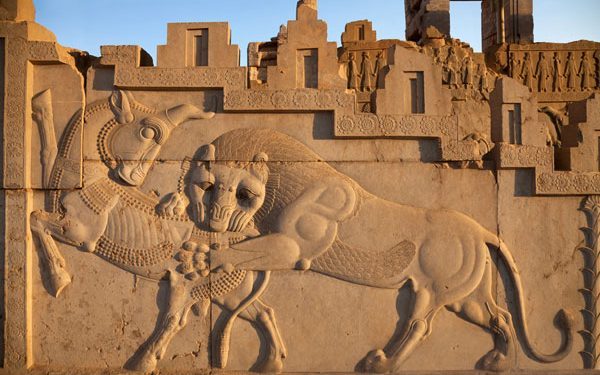
" با سلام و درود به مهمانان عزیز و کاربران گرامی وبلاگ #مهرزاد، ضمن عرض ادب و احترام به شما، این صفحه به منظور اطلاع رسانی و برای نشر آگاهی و غنی سازی می باشد،
خواهشمند است، هر گونه پیشنهاد یا انتقاد را به مدیر سایت بفرمایید. "
Mojtaba Ebrahimian
Ph.D. Student, Persian Literature and Culture Persian Language Teaching Assistant
School of Middle Eastern and North African Studies University of Arizona, Tucson, AZ
110 The American Journal of Islamic Social Science
This handbook is a reliable and authoritative guide to Iran’s history and a timely intervention in the field of Iranian studies. Daryaee has done a great job of collecting and editing the volume’s diverse and engaging essays, all of which offer the reader the entirety of Iranian history in a condensed and comprehensive form.x
Narrating the history of a nation from approximately 1,000,000 BCE to 2009 CE in 389 pages is a daunting and noteworthy task undertaken by the scholars who have contributed to The Oxford Handbook of Iranian History. This collection of sixteen short essays by distinguished anthropologists, archaeologists, historians, and philologists of the Iranian world divides Iranian history into three general periods: ancient, medieval, and modern. Chapters 1 to 7 address the ancient Iranian dynasties, chapters 8 to 13 talk about medieval Iran, and the last three focus on modern Iran.x
each chapter has been written in a way to provide “comprehensive information for students at the university level and for the uneducated layperson” (p. ii). Therefore, the book is intended to be more of an
introduction rather than a reference book for scholarly research.x
In the first chapter “The Iranian Plateau from Paleolithic Times to the Rise of Achaemenid Empire,” Kamyar Abdi traces the different patterns of settlement and social development in the Iranian plateau between approximately 1,000,000 BCE and 559 BCE. In “The Elamites,” Daniel T. Potts describes the political, social, and cultural history of this civilization that arose in southwestern Iran between the Bronze Age and the early Islamic era, prior to the rise of the Achaemenid Empire. In the next chapter, “Avestan Society,” Prods Oktor Skærvø uses a structuralist approach to analyze major themes and discusses different chapters and versions of theAvesta, a collection of texts in the Iranian Avestan language spoken during the second to first millennium BCE.x
In chapter 4, “The Achaemenid Persian Empire (550-330 BCE),” A. Shapour Shahbazi narrates the Persian Empire’s political history, various forms of cultural production, system of governance, and the composition of its armed forces from its establishment in the middle of the sixth century BCE by a southern Iranian people known as Pars or Persians until its defeat and subsequent collapse underAlexander the Macedonian in 330 BCE. In the next chapter, “Iran at the Time ofAlexander the Great and the Seleucids,” Evangelos Venetis provides a sociopolitical and economic history of Iran under the rule ofAlexander and his successors, who eventually founded the Seleucid Empire. In chapter 6, “The Arsacid Empire,” Edward Dabrowa traces the history of the Arsacid dynasty’s society, culture, institutions, and the organization from 247 BCE, when the Parthian Arsaces I established his rule in eastern Iran, until approximately 230 CE when Ardashir captured Ctesiphon and ended the Parthian Empire.x
In the last chapter allocated to ancient Iran, “The Sasanian Empire (224- 651),” Touraj Daryaee provides a sociopolitical history of the Sasanian Empire while tracing and highlighting the influence of religious (mainly Zoroastrian and Mazdaist) authorities in its society and politics. He follows the Sasanian kings’ various wars with the Roman Empire and the ensuing mutual cultural, financial, and religious impacts.
In the first chapter on medieval Iran, “Iran in the Early Islamic Period,” Michael G. Morony recounts the history of the Arab Muslim conquest of Iran and the various clashes between Muslim forces and the Sasanian army in various Iranian locations during the seventh century. He then goes on to discuss the patterns ofArab settlement in Iran during the early eighth century. He concludes chapter 8 by analyzing the roots of the Abbasid revolutionary movement that, in his view, was “one of the many contending forces that enveloped.x
the entire Islamic empire” against the Umayyad caliphate and toppled the latter and established its own rule in mid-eighth century (p. 222). Whereas other writers in their respective chapters devoted subsections to sociopolitical and political aspects of the dynasties they talk about, Morony provides no similar subsections and explains his history in a single monograph. His chapter would have matched the others if he had not devoted the majority of his analyses to Arab and Sasanian generals and the battles and places at which the two armies fought, and would have benefitted greatly if he had focused more on the sociopolitical effects of the Arab conquest.x
In “Medieval Iran,” Neguin Yavari contends that most of the sources on the pre-Islamic Iranian dynasties come from the Greeks and that the extant histories of Iran under Sasanian and Umayyad rule come from Abbasid historiographers. Since the Greeks were the pre-Islam Iranian empires’ archenemy and the Abbasids both discredited the Umayyads and lacked knowledge of pre-Islamic Iran, the histories produced by either of them – the majority of our available sources – are not reliable. Therefore the idea of an unchanging Iranian identity “stifled under” alien Arab rule is tenuous because no credible “historical narrative” is available from Iran’s “long pre-Islamic past” (p. 232). In chapter 10, “The Mongols in Iran,” George E. Lane offers a rather benign picture of the Mongols’ rule by arguing that “what began as a brutal and vindictive invasion and occupation developed into a culturally and economically flourishing period of unity and strength” (p. 243). In his view, we should not solely look at the “original sea of blood” created by the Mongols in the early decades of the thirteenth century, but also pay attention to the cultural synthesis and renaissance caused by them later in that century and the fact that part of Persians after the initial invasions began to like
their new rulers (p. 253).x
In the next chapter, “Timurids and Turcomans: Transition and Flowering in the Fifteenth Century,”AliAnooshahr provides a sociocultural and political history of the fourteenth and fifteenth centuries by tracing the Central Asian origins of the Timurids, the Turcomans, and the Safavids. He then briefly discusses the synthesis of Sufism, Islam, and Christianity during this era and their impact upon these dynasties’political power. Kathryn Babayan, in “The Safavids in Iranian History (1501-1722),” traces the genealogy of the Safavids from Shaykh Safi al-Din (d. 1334), the director of a Sufi brotherhood inArdabil and the ancestor of Isma’il, the founder of Safavid dynasty. She discusses the evolution of spiritual thought in successive Safavid monarchs and the sociopolitical and cultural implications of the Safavid state religion, Shi’i Islam, confrontation with Sufism.x
In the final chapter on medieval Iran, “TheAfghan Interlude and the Zand and Afshar Dynasties (1722-95),” Kamran Scot Aghaie offers a very brief reBook Reviews 109, ligious, economic, and political history of Iran during the “transition period” of the eighteenth century, after the Safavid Empire’s disintegration and the Afghan invasion, up to the demise of the Zand and Afshar dynasties.x
In the first chapter on modern Iran, “Qajar Iran (1795-1921),” Mansoureh Ettehadieh Nezam-Mafi summarizes the reign of all Qajar kings from their founder Agha Mohammad Shah (r. 1795-98) to their last one, Ahmad Shah (r. 1909-25). Her short account describes the role of foreign powers, especially Russia and Great Britain, in Qajar Iran’s internal affairs, sheds light on the role of the Shi’i ulema in the country’s sociopolitical scene, and recounts the events leading up to the Constitutional Revolution (1905-07). In the penultimate chapter, “The Pahlavi Era, Iranian Modernity in Global Context,”Afshin Matin-Asgari examines Reza Shah’s establishment of the Pahlavi dynasty and focuses on the external and internal factors that influenced it and led toward the Islamic Revolution of 1979. One the one hand, he follows the interaction between Iran and the dominant world powers before, during, and after the two world wars as they were pursuing their strategic interests in the country. And on the other hand, he briefly analyzes the ideologies of Marxist, socialist, nationalist, and Islamic movements and their impact on the Iranian people prior to the last Pahlavi monarch’s downfall.x
In the final chapter, “Iran after Revolution (1979-2009),” Maziar Behrooz discusses the revolution’s sociopolitical and cultural roots and follows the revolutionary nation until the controversial 2009 presidential elections. By focusing on various factions formed during and after the revolution, as well as following their respective roles on Iran’s sociopolitical scene, he divides the country’s contemporary history into five stages: the immediate years after the revolution under Ayatollah Khomeini (1979-81), the Iran-Iraq war years (1981-89), Akbar Hashemi Rafsanjani’s presidency and the postwar reconstruction period (1989-97), Mohammad Khatami’s presidency and the reform movement (1997-2004), and Mahmoud Ahmadinejad’s ascension to the presidency and his debated victory in 2009 presidential elections (2005-09).x
لطفا برای جلوگیری از قطع درختان، به جز موارد بسیار ضروری، ازچاپ روی کاغذ، خودداری فرمایید.
غنی سازی برای کار آفرینی و مدیریت با استفاده از فناوری اطلاعات و ارتباطات
